One of the most interesting periods in Dutch history resulted in the emergence of various new types of art. This included genre paintings that depict common life in the Dutch Republic.
Jan Havickszoon Steen (1626-1679) was a Dutch Golden Age painter who specialized in painting the common man during this jolly era.
He had a lot of experience as well because he was born into a wealthy Catholic brewing family who owned and operated a tavern and inn.
He never had any ambitions to take over the family business, and a brief attempt to manage his own brewery didn’t particularly end well in the 1650s.
Why? because he was a bit too fond of the alcoholic beverages his business produced.
His art was his outlet and he produced some of the most iconic Dutch Golden Age paintings in history, so let’s take a closer look at some of Jan Steen’s most famous paintings.
1. The Dancing Couple
- Date created: 1663
- Dimensions: 102.5 × 142.5 centimeters (40.4 × 56.1 inches)
- Location: National Gallery of Art, Washington, D.C., United States
The Dancing Couple is a typical Dutch Golden Age genre painting by Jan Steen as it depicts a party in a local village. This is also referred to as a “Kermis” and revolves around drinking, eating, dancing, and playing music.
The composition is centered around a dancing couple who are surrounded by people having a good time. The village can be seen in the background as the scene takes place in a vine-covered space. Despite the jolly atmosphere, Steen added several warning signs as well such as broken eggs and flowers.

2. The Happy Family
- Date created: 1668
- Dimensions: 110.5 × 141 centimeters (43.5 × 56 inches)
- Location: Rijksmuseum, Amsterdam, Netherlands
The Happy Family is a painting that is also referred to as “As the Old Sing, So shall the Young Pipe” (original Dutch title: Soo de ouden songen, so pijpen de jongen) It’s a very similar painting to The Dancing Couple but it takes place in a family setting.

As you surely expected, the old man on the left is the head of the family and is seen singing in full voice. The copious amounts of alcoholic refreshments that he is indulging in surely help with his singing voice. The meaning of the painting is that the younger generation will copy the behavior of the older one.

3. Peasants Before an Inn
- Date created: 1650s
- Dimensions: 50.2 x 61.6 centimeters (19.74 x 19.25 inches)
- Location: Toledo Museum of Art, Toledo, United States
Peasants Before an Inn depicts a remarkable scene of people having a good time before an inn and tavern. Although the painting’s title makes us assume that it’s farmers who visit this establishment, we can also see members of the upper class wearing ruffed collars.
The reason for the celebration can be seen hanging above the inn entrance. The wreath is a sign of the wine vintage, the year in which grapes are harvested to produce the fermented juice that people loved to indulge in during the 17th century.

4. Woman at her Toilet
- Date created: 1663
- Dimensions: 65.8 × 53 centimeters (25.9 × 21 inches)
- Location: Buckingham Palace, London, United Kingdom
Woman at her Toilet is a painting by Jan Steen that is full of veiled symbolism. We can see a partially undressed woman who is about to take a bath. The entire scene takes place behind an arched doorway, a threshold that we need to pass as she invitingly stares at the viewer.
The Corinthian columns and archway are elaborately decorated inspired by classical architecture. Jan Steen was an educated man who went to Latin School as a child and intelligently added a lot of symbols and Dutch proverbs to his works of art, including this one.
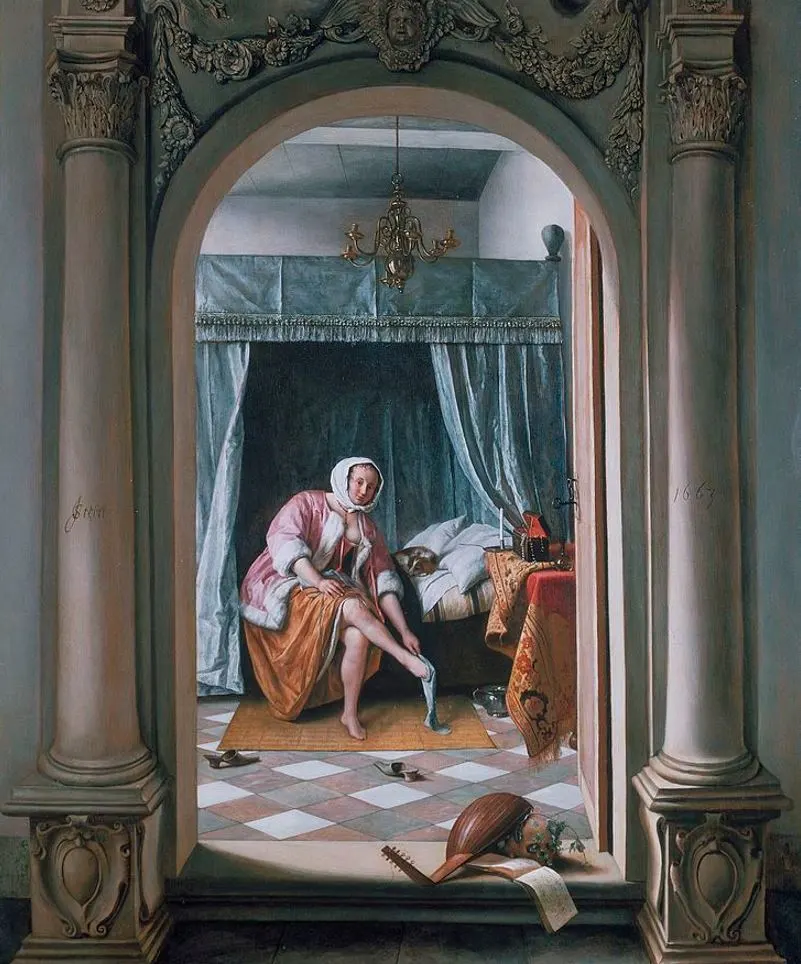
5. The Feast of Saint Nicholas
- Date created: 1665-1668
- Dimensions: 82 × 70.5 centimeters (33.5 × 27 inches)
- Location: Rijksmuseum, Amsterdam, Netherlands
The Feast of Saint Nicholas is the title of another chaotic painting by Jan Steen in a family setting. It depicts the Feast of Saint Nicholas, a feast known in Dutch as “Sinterklaas.” This yearly tradition still takes place in the Netherlands on December 5.
The composition of the painting is centered around a little girl who has apparently behaved very well in the previous year because she received a doll as a gift from Saint Nicholas. According to the local tradition, the Holy man left the gift behind in an empty shoe which can be seen lying in the foreground.
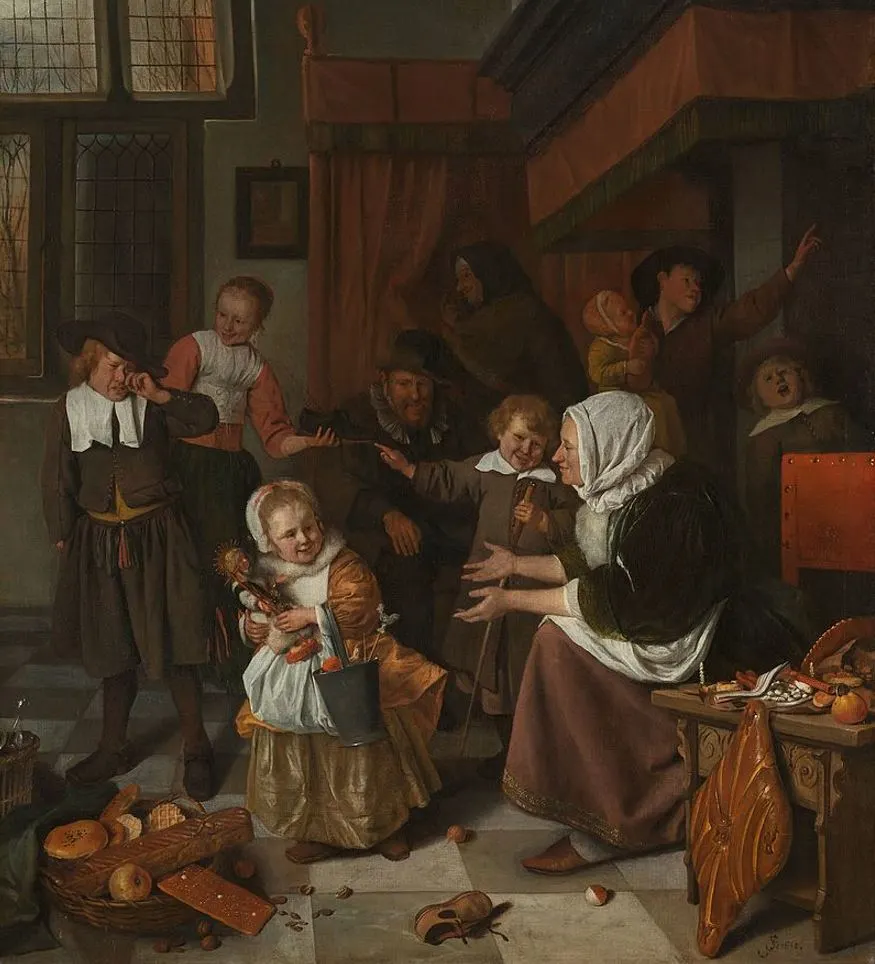
6. Winter Scene
- Date created: 1650
- Dimensions: 66 x 96 centimeters (25.98 x 37.79 inches)
- Location: Skokloster Castle, Håbo Municipality, Sweden
Winter Scene is the title of a Jan Steen painting that the artist completed while he was still in his early twenties. It emphasizes the versatility of the Dutch painter because he produced a wide variety of subjects, including landscapes.
Completed in the early 1650s, the painting was acquired by the Swedish ambassador to the Dutch Republic and brought back to Sweden in 1651. It was purchased on behalf of Swedish statesman and military commander Carl Gustaf Wrangel who bought 3 other paintings by Steen as well.
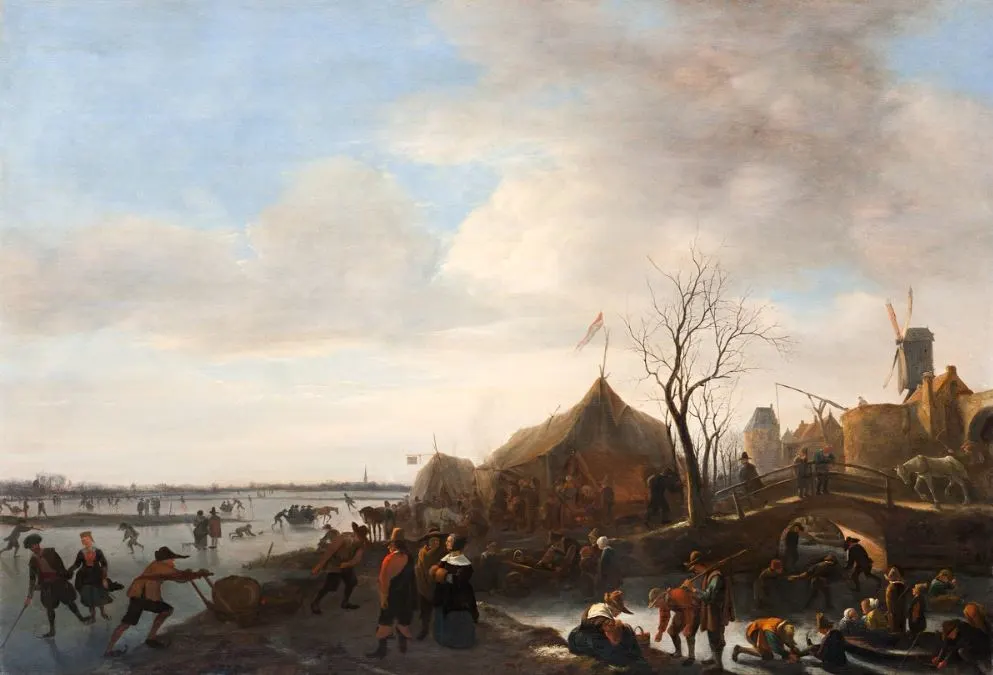
7. Rhetoricians at a Window
- Date created: 1663-1665
- Dimensions: 75.94 x 58.62 centimeters (29.9 x 23 inches)
- Location: Philadelphia Museum of Art, Philadelphia, United States
Rhetoricians at a Window is a fascinating work in the oeuvre of Jan Steen and that’s not only because of the amazing composition or subject matter. Rhetoricians were members of the local theater guild and as you can see, these actors easily made people laugh back then.
Many art historians have suggested that Jan Steen was heavily influenced by the “Rederijkers” and included many figures from plays he saw in his paintings. If this is true, it also means that it’s hard to judge whether the figures in his art are real people or theater characters.
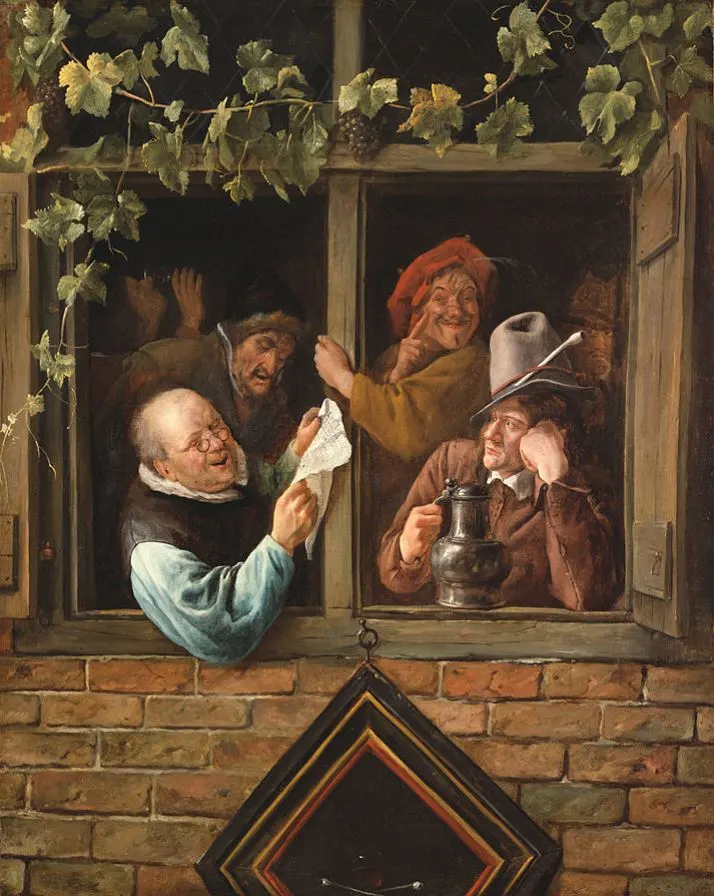
8. Beware of Luxury
- Date created: 1663
- Dimensions: 105 × 145.5 centimeters (41 × 57.3 inches)
- Location: Kunsthistorisches Museum, Vienna, Austria
Beware of Luxury is a painting that completely embodies the warning signs that are usually only hinted at by Jan Steen in other works. Just about everybody in this chaotic scene indulges in improper behavior such as excess or self-indulgence.
The painting is Steen’s depiction of the Dutch proverb “In weelde siet toe” which means that you need to look out for the consequences of apparently good times. The funny part about the painting is that the woman of the house has fallen asleep and this is taken advantage of by everybody else.
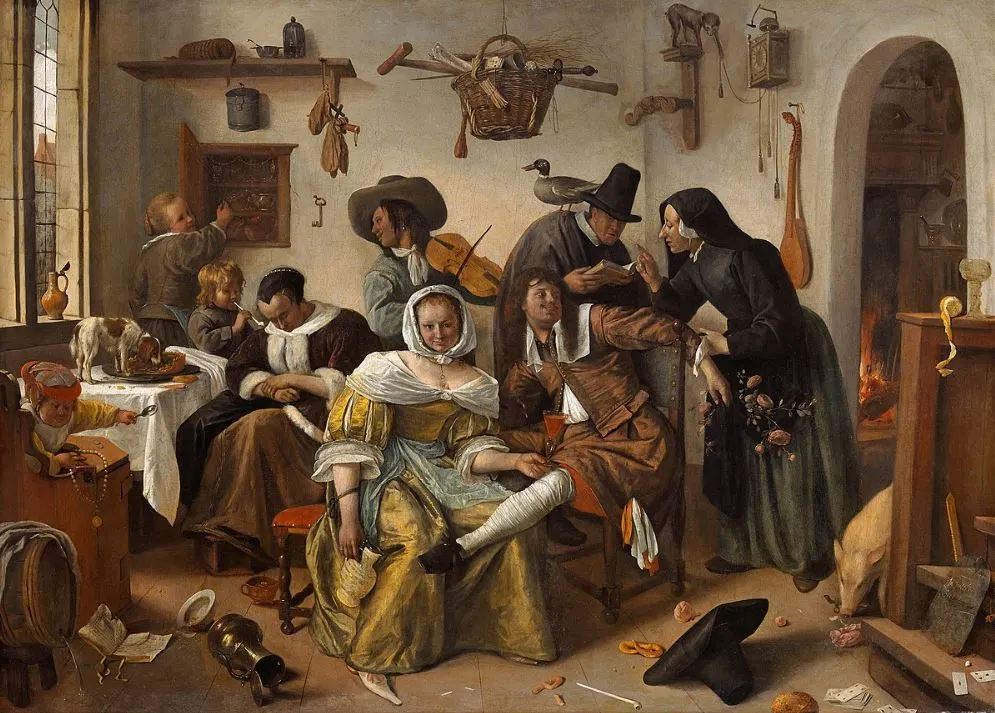
9. A Mayor of Delft and his Daughter
- Date created: 1655
- Dimensions: 82.5 × 68.7 centimeters (32.5 x 27 inches)
- Location: Rijksmuseum, Amsterdam, Netherlands
A Mayor of Delft and his Daughter is the title commonly used to describe one of the few paintings that Jan Steen completed while he lived in Delft. This was the time that he tried his luck running his own brewery following the explosion in Delft in 1654 and the subsequent art market crash.
Even though it has always been assumed that it depicts the mayor of Delft and his daughter, more recent research uncovered the true identity of the sitters as a Double portrait of Adolf Croeser (1612-1668) and his daughter Catharina Croeser. The tower of the Oude Kerk (Old Church) in delft identifies the location.
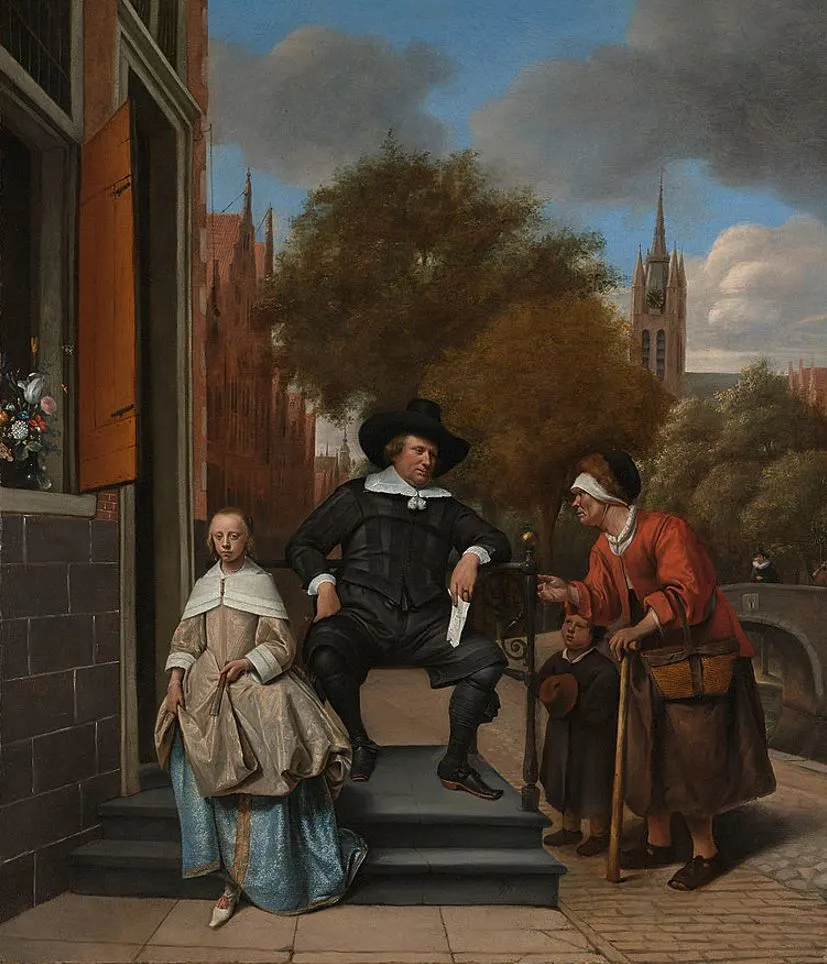
10. The Dissolute Household
- Date created: 1663-1664
- Dimensions: 108 x 90.2 centimeters (42.5 x 35.5 inches)
- Location: MET Museum, New York City, United States
The Dissolute Household is a painting that not only embodies the spirit of the Dutch Golden Age but also that of the life of Jan Steen himself. There’s a Dutch saying that says “To Run a Household Like Jan Steen” and this refers to the chaotic life he lived.
Intelligent as he was, he recognized his behavior and often included himself in his paintings. The man in the center of this domestic chaos is the painter himself. At least, he tried to have fun during his time, even though he always knew that ominous dark clouds hung above his head.

